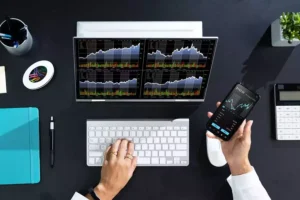Can you imagine trading without accurate planning and rigorous oversight? The primary approach to successfully making trades is keeping a record of the orders. A trader can’t work without a trade order management system. The application serves as a dependable helper when it comes to transactions. It ensures that you can connect to the trading world seamlessly. To clarify how crucial it is to utilize this system, we will explore its fundamental specifics in this article.
Understanding a Trade Order Management System
Today, traders get the most from the trade order management system (TOMS). The system determines the most optimal route for order execution, considering factors like price, liquidity, and regulations.
TOMS keeps the trading life cycle seamless. It’s invaluable if you’re new to the OMS trading environment. It assists with order creation, determining execution routes, and tracking actual-time execution progress. Additionally, the OMS facilitates allocation of shares in case of bulk orders, confirms and settles executed trades, and provides comprehensive reporting and analytics for informed decision-making.
The trade order management system executes orders by applying a software system and the Financial Information Exchange (FIX) protocol. Real-time worldwide info-sharing takes place using this electronic communication system. The purpose of OMS is to load the daily opening positions so that traders may view their positions. With quick trade tickets, firms could react swiftly to market conditions. They could also divide orders for proper distribution and route bundled orders via FIX to many sell-side fulfillment offices. Applying OMS, the FIX protocol links investment companies and hedge funds with thousands of clients throughout the globe.


Turnkey Brokerage Solution For Your Business
Get the most profitable fully licensed fx/crypto brokerage software or ready-to-operate business in 48 hours. Best-in-class web & mobile trading platforms, sales-driven CRM, full integration with MT4/5, and 150+ payment providers.
Key Features and Functions of a TOMS
TOMS is a specific platform that provides traders with numerous options. Managers of portfolios may now generate and edit orders. Orders might be derived from external and internal sources, allowing operational flexibility in order management system in trading. Let’s examine this system’s primary characteristics and subtleties.
Workflow automation
With OMS providers, traders can quickly automate their trading. Because there is little to no human participation in the order execution, traders will no longer be susceptible to human mistakes. Before order completion, such automation ensures full approval and compliance processes.
Portfolio management
Systems that help you manage portfolios are an indispensable element of TOMS. Thanks to this, you may now view positions, assess risks, and monitor your funds in one place. Thus, you make well-thought-out decisions.
Allocation of trade
The trade order management system has unique features for placing orders across many funds or accounts to guarantee equitable and precise trade distribution. As a result, the software facilitates the issuance of shares across various customers or investing approaches.
Monitoring in real-time
Dashboards and reports on the platform are easy to navigate. You may now follow the order progress and status in real time.

Users of Trade Order Management Platforms
Various participants in the financial environment utilize trade order management platforms to streamline and enhance their trading operations’ efficiency. The primary users of these platforms include:
- Asset managers and investment firms: Asset managers and investment firms use such platforms to handle the entire lifecycle of trade orders, ensuring efficient execution and compliance with investment strategies.
- Brokerage firms: Brokerages employ trade OMS to simplify order execution for their clients. These platforms enable brokers to manage and execute trades efficiently, ensuring timely and accurate order fulfillment.
- Institutional investors: Large market players, such as pension funds and insurance companies, utilize TOMS to manage their extensive portfolios. The platforms assist in handling bulk orders, distribution, and compliance with investment guidelines.
Individual financial advisors often use simplified versions of OMS to manage trades on behalf of their clients. These platforms assist in maintaining diversified portfolios and executing trades efficiently.
Advantages of Trade Order Management System
Traders enjoy numerous advantages from such systems. Let’s look at the reasons that make TOMS a reliable trading assistant:
- You may eliminate manual involvement because the system automates procedures and helps you to hike up operational efficiency.
- During transaction execution, dissemination, and compliance checks, there is a decreased possibility of human mistakes.
- Thanks to the system’s automatic compliance checks and seamless reporting, meeting complicated regulatory obligations is made manageable.
- Easy-to-use actual data and analytics help in decision-making.
- Order management solutions evaluate and control the risks related to agreement implementation. It offers insightful data to increase the portfolio’s overall efficacy.
After all, order fulfillment and precise distribution methods support better client connections and higher levels of customer satisfaction.
How to Choose an Appropriate Trade Order Management System
If you’re a broker searching for the ideal fit for you, keep in mind that no program is suitable for everyone. Every OMS has unique traits and characteristics. You must first concentrate on the goals you have for this program. Let’s examine the primary determinants of the decision:
- Price. Determine the approximate pricing range you are ready to pay for the program. Still, you ought to take notice of the free-of-charge choices as well. Although they could provide various free services, it’s also essential to consider their possible fees.
- Market. Determine if there are any market or geographic restrictions on the OMS. Recognize whether it serves particular categories or allows securities trading.
- Ease of usage. Only when your staff members feel at ease utilizing the application will your system provide outstanding outcomes. Should the TOMS include intricate features, your employees must possess the necessary expertise to operate it.
- Opportunities for integration. A fully functional off-the-shelf system or even a modular system that seamlessly interfaces with pre-existing tools like PMS is what consumers sometimes desire.
Trade order management system vendors offer a range of solutions with attributes tailored to particular investors. Components might include distribution models, risk management tools, reporting specifics, automation, and auditing features, among many other things. Establish an internal feature list that includes both necessary and desirable characteristics to determine which OMS solution is best. This strategy ensures that the necessities are met without going overboard with expensive extras.
To cap it all, having a trustworthy order management platform is indispensable. To amplify your brokerage performance, use XCritical’s management solutions, your one-stop marketplace. It’s more than just order management with features like CRM, AMS, XCritical Trading Platform, and SmartBot. It’s all about making your brokerage experience more effective and seamless. Whether you are a novice or a seasoned business owner, these solutions provide simplicity and power.






